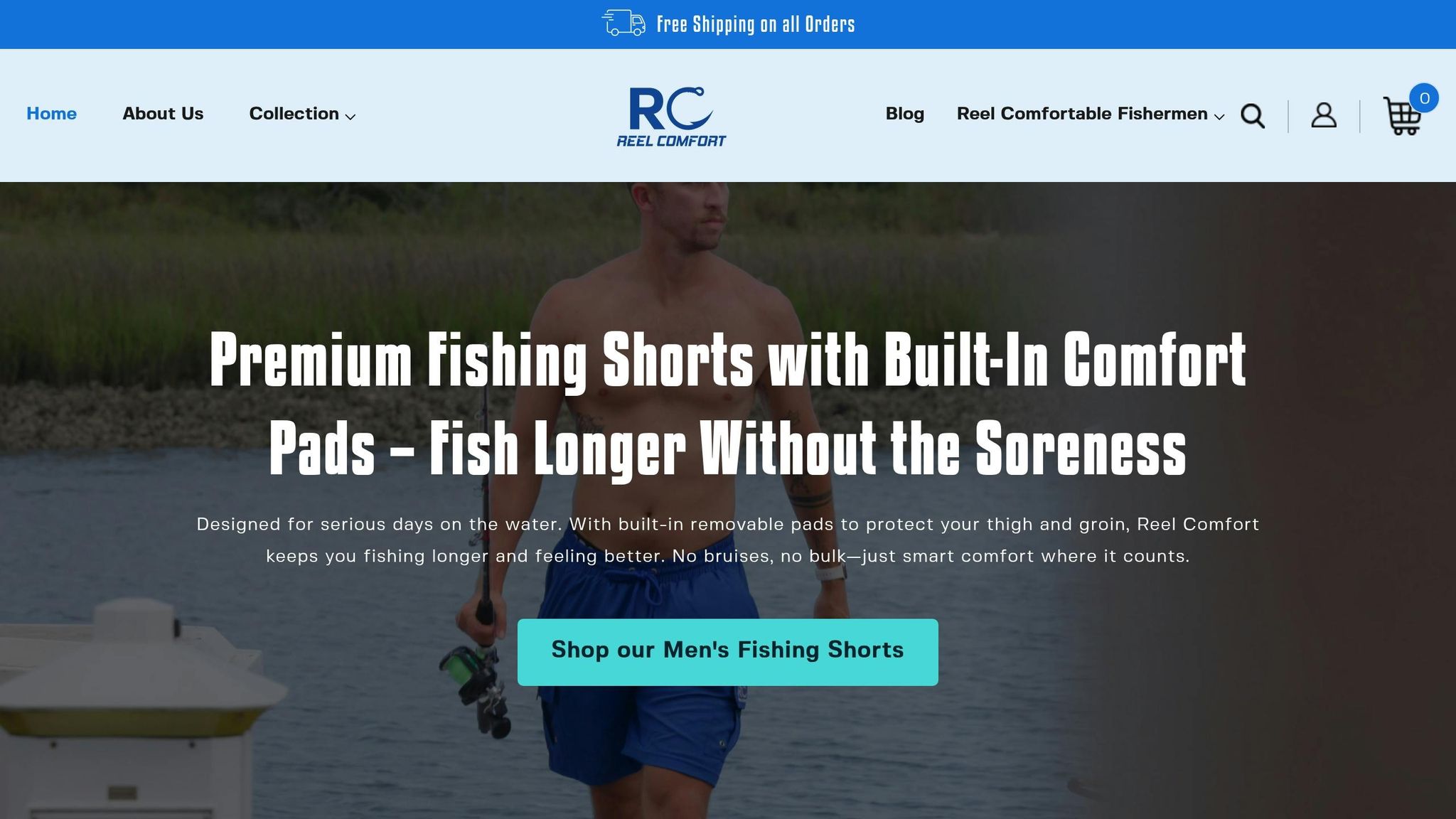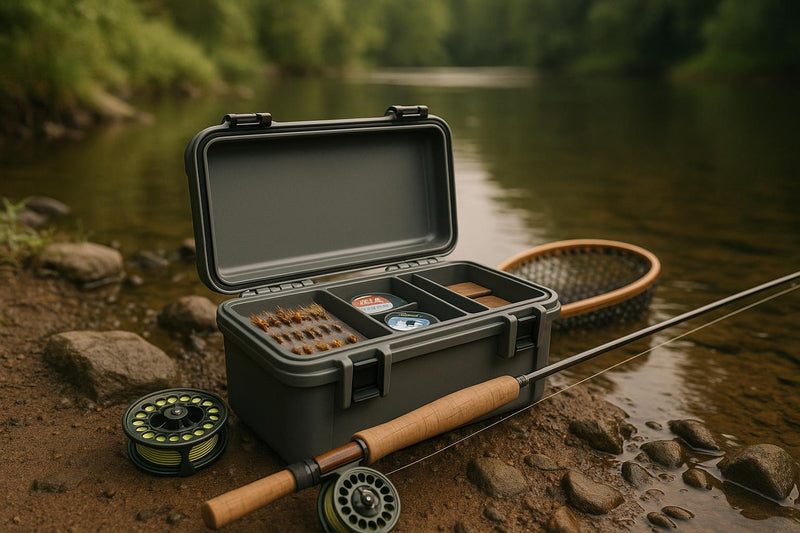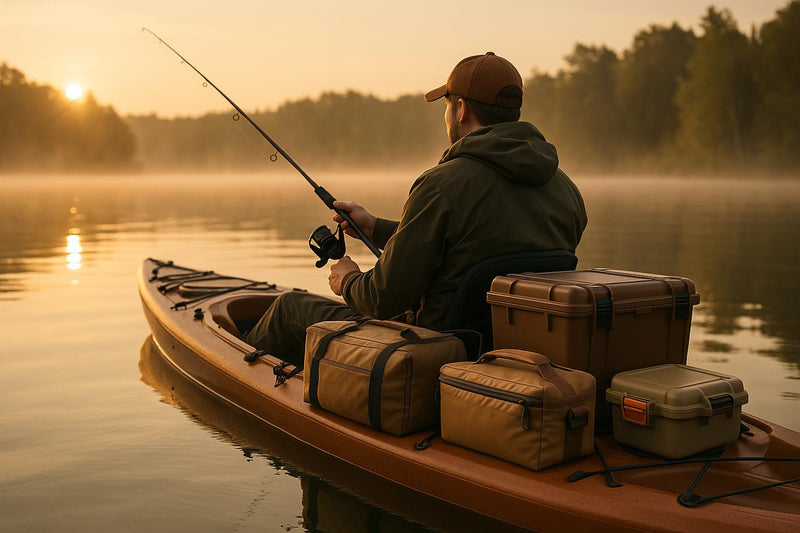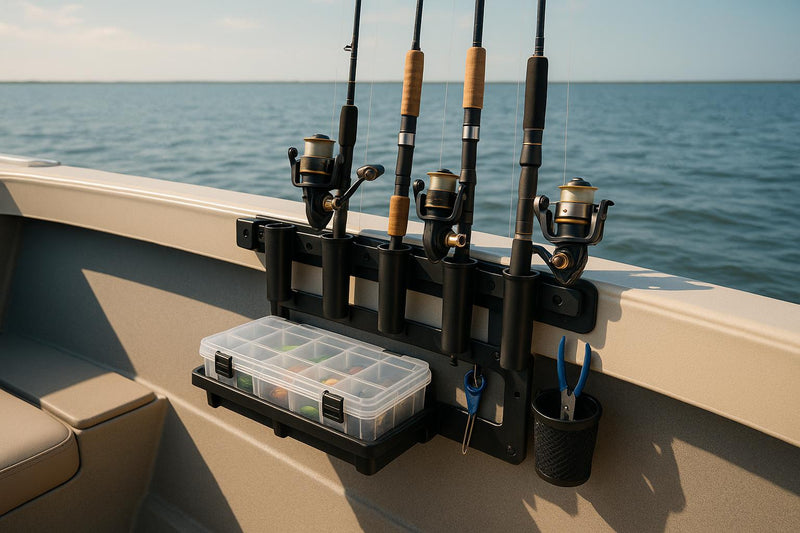Waterproofing in fishing gear keeps you dry by repelling water from fabric surfaces. Traditional methods used PFAS and PFC chemicals, known for their durability but harmful environmental effects. These "forever chemicals" persist in ecosystems, contaminating water and wildlife.
The industry is now shifting to safer, PFC-free alternatives like silicone-based and bio-based coatings. These options prioritize performance while reducing harm. Brands are also incorporating recycled materials and designing longer-lasting gear to minimize waste.
For anglers, this means durable, water-resistant gear that aligns with efforts to protect the waters they love. Products like quick-dry fishing shorts are now built with eco-conscious treatments, balancing functionality and responsibility.
Standard Waterproofing Methods in Fishing Gear
When it comes to fishing gear, waterproofing isn’t just a convenience - it’s a necessity. Different methods are used to keep anglers dry and comfortable, each with its own approach to protecting against water. Let's take a closer look at how these methods work, especially in products like fishing shorts.
Durable Water Repellent (DWR) Coatings
Durable Water Repellent (DWR) coatings are a widely used method for waterproofing fishing gear. These coatings create a thin, hydrophobic layer on the fabric's surface, causing water to bead up and roll off instead of soaking into the material. Typically applied during manufacturing, DWR coatings can be added through techniques like spraying, dipping, or foam finishing. The treatment bonds with the fabric fibers, forming a barrier that keeps water out while maintaining the flexibility and comfort anglers need for activities like casting and reeling. This makes them a popular choice for products such as men’s fishing shorts.
PFAS/PFC-Based Treatments
For years, PFAS (per- and polyfluoroalkyl substances) and PFC (perfluorinated compounds) treatments were the go-to for waterproofing. These fluorinated compounds excel at repelling water and oil, thanks to their strong carbon-fluorine bonds. They provide a durable, long-lasting barrier that stands up to repeated washing and exposure to harsh marine conditions.
However, the very stability that makes these treatments so effective has also raised environmental red flags. PFAS and PFC compounds persist in the environment, often finding their way into water systems through washing or disposal. This persistence can harm wildlife and ecosystems, leading to growing concerns about their impact and prompting a search for safer alternatives.
The Shift to PFC-Free Options
In response to both environmental concerns and regulatory pressures, the industry is moving toward PFC-free waterproofing solutions. These newer treatments eliminate fluorocarbon compounds entirely, opting instead for alternatives like silicone-based coatings, wax treatments, or bio-based solutions derived from natural materials.
While PFC-free options may require a bit more upkeep than traditional PFAS treatments, they’ve come a long way in terms of performance. Today’s formulations deliver excellent water resistance while aligning with efforts to protect the environment. For instance, water-resistant fishing shorts now often incorporate eco-friendly treatments alongside advanced fabric technologies like quick-dry materials to ensure top-notch performance.
This shift highlights a critical evolution in fishing apparel: effective waterproofing can coexist with environmental responsibility. It’s a win-win for anglers looking to stay dry and comfortable while also supporting sustainable practices in the gear they choose.
Environmental Effects of Waterproofing Chemicals
Waterproofing chemicals used in fishing gear provide much-needed water resistance, but they come with a hidden cost: long-term environmental damage. This is particularly true for PFAS and PFC compounds, which are highly effective at repelling water but linger in the environment indefinitely. Recognizing these impacts has driven the industry to explore more sustainable options, like water-resistant fishing shorts designed with eco-conscious innovation. Let’s take a closer look at the environmental challenges posed by these chemicals and the push for greener solutions.
PFAS and PFC: The "Forever Chemicals"
PFAS and PFC chemicals are often referred to as "forever chemicals" because they don't break down easily and remain in the environment for an extended period. This persistence leads to bioaccumulation in both wildlife and humans, while also contaminating rivers, lakes, and fish. For outdoor enthusiasts and anglers, this contamination threatens the very ecosystems they value, creating a pressing environmental issue that needs addressing.
The Lasting Impact of Treated Gear
The environmental footprint of fishing apparel treated with PFAS and PFC chemicals extends far beyond its active use. Even after disposal, these compounds continue to pollute, leaving a lasting ecological mark. This underscores the importance of reducing long-term harm by opting for sustainable alternatives. For instance, Reel Comfort's men's fishing shorts are designed with this in mind, offering an eco-friendlier solution to traditional waterproofing treatments. By making informed choices, we can help reduce the enduring damage caused by these persistent chemicals.
New Eco-Friendly Waterproofing Technologies
The fishing apparel industry is embracing new waterproofing methods that deliver excellent performance while steering clear of harmful chemicals.
PFC-Free Durable Water Repellents
Many top brands are now turning to PFC-free DWR (Durable Water Repellent) finishes, which provide strong water resistance without relying on fluorocarbons. These companies have already phased out C8 fluorocarbons and are actively reducing the use of C6 PFCs in their products.
Patagonia, for instance, has taken a bold step by pledging that, starting Spring 2025, all new products will be free of intentionally added PFAS. This commitment follows nearly 15 years of work, including eliminating C8-based treatments between 2013 and 2016 and introducing PFAS-free DWR finishes in Fall 2019.
Some products now feature C0 DWR finishes, which offer effective water resistance while being more environmentally friendly. Upcoming regulations in states like California and New York, banning intentional PFAS in textiles beginning January 1, 2025, are further driving this shift. This change is evident in items like Fishing shorts, which now combine performance with environmental consciousness.
These advancements are setting the stage for more sustainable practices across the entire apparel industry.
Recycled Materials and Closed-Loop Manufacturing
In addition to chemical innovations, the use of sustainable materials is reducing environmental impact. Modern fishing apparel increasingly incorporates recycled polyester and reclaimed fabrics, cutting down on waste while maintaining durability and water resistance. This approach aligns with the growing demand for environmentally conscious solutions, as seen in the thoughtful design of Fishing shorts.
Closed-loop manufacturing systems take sustainability a step further by reusing production waste and designing products that can eventually be recycled. When paired with eco-friendly waterproofing treatments, these efforts create fishing gear that performs just as well as traditional options, all while protecting the waters anglers care about.
Care and Maintenance Tips for Longer Use
To get the most out of your eco-friendly gear, regular maintenance is key. Unlike traditional treatments, eco-friendly DWR finishes may need more frequent care and reapplication to maintain their water-repellent properties. Using eco-friendly sprays and cleaning your gear regularly helps keep it performing at its best.
Keeping your outerwear clean is especially important. Dirt, oils, and salt can reduce the effectiveness of any DWR treatment, so routine cleaning is essential. For anglers who invest in high-quality Men’s Fishing Shorts, proper care ensures these eco-friendly treatments continue to protect you season after season. Not only does this extend the life of your gear, but it also reduces the need for replacements, cutting down on waste and making your investment in sustainable fishing apparel go even further.
sbb-itb-cb0a783
Case Study: Reel Comfort's Water-Resistant Fishing Shorts

Reel Comfort strikes a smart balance between high-performance fishing gear and a commitment to environmentally conscious practices. Their Fishing Shorts cater to anglers who need durable, comfortable apparel for long days on the water. This case study highlights how eco-friendly innovations can enhance both functionality and environmental awareness.
Water-Resistant and Quick-Drying Fabrics
At the core of Reel Comfort's design is advanced fabric technology that combines water resistance with quick-dry capabilities. Their Men's Fishing Shorts are made from materials that repel moisture, causing water to bead up and roll off. At the same time, the fabric remains breathable, ensuring comfort even during extended wear. Thanks to four-way stretch panels, the shorts allow for unrestricted movement, creating a reliable barrier against wind and water while drying quickly to keep you comfortable.
Thoughtful and Functional Design
Reel Comfort pairs high-tech fabrics with a design that prioritizes comfort and practicality. These shorts feature removable thigh pads, which help distribute the weight of a fishing rod and reduce strain during long fishing sessions. Ergonomically placed pockets make essential tools easily accessible, while anti-chafe seams prevent irritation over hours of wear. Reinforced stitching and a design tailored for active fishing techniques ensure these shorts can handle the demands of serious anglers.
Performance Meets Environmental Responsibility
Reel Comfort doesn’t just focus on performance - they’re also dedicated to sustainability. By using rip-stop fabric construction, they create gear that lasts longer, reducing the need for frequent replacements and, in turn, cutting down on waste. This durability-first approach shows that anglers don’t have to choose between high-quality gear and responsible manufacturing practices. Reel Comfort proves that well-designed products can deliver on both performance and longevity, making them a solid choice for eco-conscious fishing enthusiasts.
Conclusion: The Future of Eco-Friendly Fishing Apparel
The fishing apparel industry is navigating a new era where performance and environmental care go hand in hand. While traditional PFAS-based waterproofing treatments have provided excellent water resistance, their long-lasting environmental impact and potential health hazards have prompted a shift toward greener alternatives.
In response to these concerns, manufacturers are adopting PFC-free solutions. These include bio-based coatings, recycled materials, and closed-loop production methods, all designed to maintain high performance while minimizing harm to the environment. This shift signifies a commitment to creating gear that doesn’t just perform well but also supports a healthier planet.
Durability is another key focus. Long-lasting gear reduces waste, lowers emissions, and conserves resources. Take Reel Comfort's rip-stop construction, for example. Their Fishing shorts showcase how water-resistant, quick-dry fabrics can deliver top-notch performance without relying on harmful chemical treatments.
Modern designs like Men's Fishing Shorts with four-way stretch and ergonomic features prove that water resistance, breathability, and durability can align seamlessly with eco-conscious practices. For anglers looking to combine peak performance with sustainable design, Reel Comfort's Fishing shorts lead the charge.
As waterproofing technology continues to advance, the future of fishing apparel lies in merging high performance with environmental responsibility. Anglers increasingly understand that protecting the waters they cherish starts with making thoughtful gear choices. The industry's move toward sustainable waterproofing is more than a trend - it's a pledge to safeguard fishing environments for generations to come. High-performance and eco-conscious design are no longer separate goals; they are becoming the new standard in fishing gear.
FAQs
What are the environmental risks of PFAS and PFC chemicals in fishing apparel, and why are they called 'forever chemicals'?
PFAS (per- and polyfluoroalkyl substances) and PFC chemicals are often called "forever chemicals" because they degrade at an incredibly slow rate in the environment. Their durability comes from strong carbon-fluorine bonds, which make them stick around for decades, building up in soil, water, plants, animals, and even humans.
In fishing apparel, these chemicals are frequently used to create water-resistant and waterproof finishes. While practical, this widespread use has serious consequences. Over time, these substances contribute to environmental pollution, disrupting ecosystems and harming aquatic life. They can also seep into water supplies and food chains, creating health risks for people. Choosing fishing gear treated with non-toxic, eco-friendly alternatives is a smarter option for protecting both the planet and ourselves.
How do PFC-free waterproofing treatments compare to traditional PFAS-based options in fishing apparel?
PFC-free waterproofing treatments present a more environmentally conscious choice compared to traditional PFAS-based options. However, they might not match the same level of durability and water resistance, especially in harsh conditions. PFAS treatments are known for their exceptional water-repelling abilities, but their negative impact on the environment has spurred a growing interest in greener alternatives.
Recent developments in PFC-free technology are narrowing the performance gap, offering anglers a practical and eco-friendly solution. For those aiming to minimize their environmental footprint, these treatments provide a reliable option that balances sustainability with functionality in most fishing conditions.
How can I maintain the durability and water resistance of eco-friendly waterproof fishing apparel?
To keep your eco-friendly waterproof fishing gear performing at its best, start by washing it with a mild detergent made specifically for waterproof fabrics. Skip the fabric softeners - they can wear down the water-resistant coating. When it comes to drying, air drying is your best bet to maintain the material's durability.
Every so often, reapply a PFAS-free durable water repellent (DWR) treatment to refresh its water-resistance. Also, keep an eye out for any tears or damage, and fix them right away with patches or adhesives. Following these simple care tips will help your gear stay reliable and ready for many fishing adventures ahead.




